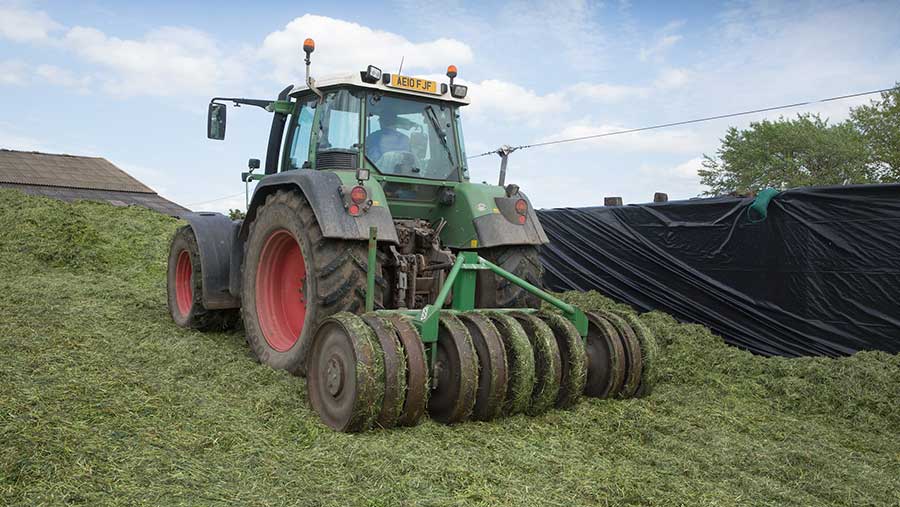Guide to preventing mycotoxins in silage
 © Tim Scrivener
© Tim Scrivener Forage can present a high risk of mycotoxin contamination to livestock. Farmers Weekly looks at what producers can do to minimise the risk in silage crops.
Mycotoxins pose a challenge for all livestock systems, yet they often fall under the radar. Not only do they cause reductions in health and performance, they also eat into profit margins.
Because mycotoxin producing moulds aren’t usually visible and the clinical symptoms of contamination are typically wide-ranging and subtle, farmers often fail to pinpoint them as the cause of many health issues in livestock.
Contamination signs
Signs of mycotoxin contamination can be subtle, but symptoms in cattle include:
- Inefficient feed use
- Digestive disturbances
- Compromised health status such as increased somatic cell counts
- Compromised reproductive performance such as reduced conception rate and abortions
With ensiled feeds such as grass silage being a major culprit in UK livestock systems, prevention of mycotoxin contamination in forage really begins at harvest.
Producers should try to avoid mycotoxin producing moulds being brought into the clamp in the first place.
Attention should then turn to creating a stable storage environment, that doesn’t enable moulds and fungi to grow and proliferate.
See also: 8 common mistakes to avoid at silage harvest
The key steps to preventing mycotoxin risk in silage:
1. Ensile the crop at the correct stage of maturity
While a mature crop with lower digestibility value is often acceptable depending on what you are feeding it to, it’s worth remembering older crops are more vulnerable to attack in the field by fungal pathogens.
This can then result in the production of field-borne mycotoxins, such as Fusaria, which will be transferred into the silage clamp.
2. Adjust the cutting height
If the crop is more mature, consider a cutting height of at least 7.5cm to 10cm from the base of the stem. The bottom of the stem poses the highest risk of diseased material and has the lowest digestibility and nutritive value.
3. Wilt rapidly
The crop should be spread immediately in the field to achieve a rapid wilt. This is especially important in heavy yields as leaving it in a swath reduces the evaporation of water and can trap moist air.
This creates a warm humid environment which encourages the growth of yeasts and moulds, that’ll then contaminate the ensiled crop, resulting in storage formed mycotoxins.
4. Compact well
Aim to achieve a target density of 750kg/cu m of fresh matter or 220-250kg/cu m of dry matter. This can be achieved by layering the forage in the pit in layers no thicker than 15cm and rolling each layer before the next load comes in.
By doing this, you’ll achieve the high density required, which will reduce the yeast numbers in the silage significantly.
The result will be a much more aerobically stable silage, that shouldn’t heat up, therefore reducing the risks of mould growth and mycotoxin formation.
5. Sheet up well
Use a side sheet, oxygen barrier film and top sheet, and then apply enough top weight, paying particular attention to the junction between the wall, the top sheet and the ramp.
It’s vital to keep air out, as oxygen allows yeasts and moulds to survive and grow, reducing the nutritive value of the silage and increasing the mycotoxin risk.
6. Good clamp management
While good harvest and storage management is key, it’s also important that livestock producers manage the clamp well when feeding-out.
The clamp face should be kept clean and tight; a shear grab is the best way to achieve this. It’s also important that producers move across the clamp face as quickly as possible. Ideally, the clamp face should be moved across every three to four days, especially during warmer weather.
7. Discard visibly mouldy feed
While a lot of mould and fungi aren’t visible, some, such as penicillium moulds, are noticeable by sight. In this instance, it’s important that any obviously mouldy feed is discarded. It is also advisable to clean out feeder wagons and troughs on a regular basis.
8. Carry out a mycotoxin test
Despite adopting best practice during harvest and when managing the clamp during feeding out, there is still potential for mycotoxin contamination. Producers should analyse total mixed rations with a broad-spectrum mycotoxin test.
Expert advice came from Andrew Linscott, ruminant manager at Alltech and Dave Davies from Silage Solutions UK
